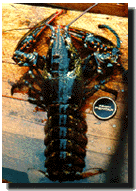
Lobster fishing is Prince Edward Island’s most
famous and historically most successful fishery. It is an
important part of our heritage and a source of great
pride to Islanders. In the not too distant past, lobsters
were so abundant that they were used as fertilizer on
farmers’ fields. Today, however, the heretofore
humble lobster has acquired the status of delicacy; its
delicate white meat hidden under a bright red shell once
cooked.
The type of lobster we fish is called the American
lobster (Homarus americanus). It is found only
on the eastern coast of North America from Labrador in
the north to North Carolina in the south. The richest
fisheries are located in southern Nova Scotia and the
southern Gulf of St. Lawrence (around Prince Edward
Island) where the lobsters thrive in coastal waters, on
rocky bottoms to depths of 40 fathoms. When alive, a
lobster is usually greenish-blue, speckled with dark
spots. A decapod crustacean, it has ten legs and a
crust-like shell. The large front claws are effective in
capturing food and warding off enemies. The
lobster’s powerful tail muscles enable the animal to
shoot backwards quickly when startled or in danger.
Feeding on a diet of other crustaceans, fish, and
shellfish, a seven year-old lobster weighs about one
pound and measures 9 1/2 inches in length.

A heavy gale in August 1873 drove lobsters ashore for
miles along the north coast of Prince Edward Island, one
to five feet deep. While this was a unique occurrence, it
does confirm the abundance of lobster in our waters. It
was inevitable that we would turn this abundance to our
advantage and derive from it a lucrative industry. During
the days of early settlement, lobsters were picked from
the rocks on shore, then Islanders fished them using dip
nets and poles and, later, boats propelled by oars or
sails. Today, lobster fishers employ state-of-the-art
technology, from radar devices and depth finders to
high-powered engines.
The most commonly used lobster trap in Prince Edward
Island is the “parlour” type trap, which has a
flat bottom. The sides and top are arched, shaped like a
semi-circle. The trap has two funnel-shaped openings
called “heads” though which lobsters pass in
search of food; frequently used baits include herring,
mackerel, flounder, and perch. Once inside, another
“head” leads to a section called the
“parlour,” from which the lobsters cannot
escape. The traps are weighted with stones to make them
sink and up to ten traps are attached to one main line.
Their position is marked by a buoy coloured brightly to
differentiate the traps of many fishers.
Lobster fishing seasons vary in each of the three fishing
zones around the Island. In Zones 24 and 26, along the
north shore, from North Cape in the west to East Point
(Zone 24) and along the south and eastern shore, from
Victoria Harbour east to East Point (Zone 26), the
lobster season lasts from April 30 until June 30. In Zone
25, which extends from North Cape south along the coast
and then east to Victoria Harbour, the season begins on
August 9 and ends on October 10.
On the Island, lobster may be purchased live in the shell
or freshly cooked in the shell and are sold as canners,
weighing between 1/2 and 3/4 pounds (250–375 grams)
or as markets weighing over 3/4 pounds. Lobster is also
sold as cold pack (the meat is frozen in cans), hot pack
(the meat is heat processed in cans), cocktail, chowder,
paste, or frozen whole in the shell.
